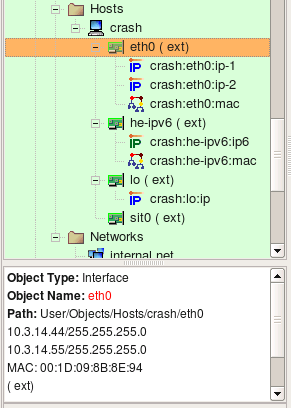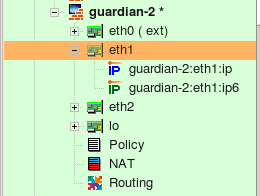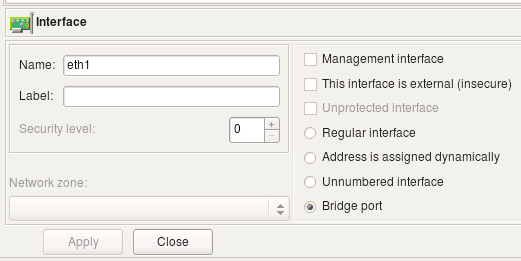Search Users Guide
Interface objects belong to firewall or host objects. Interface objects cannot exist alone.
The dialog for the interface object that belongs to the firewall or host provides controls for the parameters described here. Controls that are only valid for the firewall, and not host objects, are marked as such.
Name: The name of the interface object in Firewall Builder must match exactly the name of the interface of the firewall machine it represents. This will be something like "eth0", "eth1", "en0", "br0", and so on.
Label: On most OSs this field is not used and serves the purpose of a descriptive label. Firewall Builder GUI uses a label, if it is not blank, to show interfaces in the tree. One of the suggested uses for this field is to mark interfaces to reflect the network topology (for example, "outside," "inside") or the purpose ("web frontend" or "backup subnet"). The label is mandatory for Cisco PIX though, where it must reflect the network topology.
Management interface: When a firewall has several network interfaces, one of them can be marked as the "management interface". The management interface is used for all communication between Firewall Builder and the firewall. For example, the built-in policy installer uses the address of the management interface to connect to the firewall via SSH when it copies a generated script or configuration file. (This object applies to firewall objects only.)
External interface (insecure): Marks an interface that connects to the Internet, or to an area that is outside the network protected by the firewall. (This obect applies to firewall objects only.)
Unprotected interface: Marks interface to which Firewall Builder should not assign any access lists or firewall rules. Unprotected interfaces are recognized by policy compilers for Cisco IOS access lists and PF. Compiler for IOS ACL just skips unprotected interfaces and does not assign any ACL. The compiler for PF generates a "set skip on" clause for unprotected interfaces. (This obect applies to firewall objects only.)
Regular Interface: Use this option if the interface has an IP address assigned to it manually (static IP address).
Address is assigned dynamically: Use this option if the interface has a dynamic address (obtained by means of DHCP or PPP or another protocol). In this case, an address is unknown at the moment when Firewall Builder generates the firewall policy. Some firewalls allow for using the interface name in the policy instead of its IP address; the firewall engine then picks an address either when the policy is activated or even at run-time. Some other firewalls support special syntax for rules that are supposed to match packets headed to or from the firewall machine. Examples of these two cases are OpenBSD PF and Netfilter. PF rules can be constructed using interface names; PF automatically uses the current interface address when it loads rules into the memory. Netfilter supports special "chains" called "INPUT" and "OUPUT" that are guaranteed to inspect only packets destined for the firewall machine ("INPUT") or originated on it ("OUTPUT"). Both methods allow Firewall Builder to build correct firewall policy rules that affect the interface with a dynamic IP address; however, the interface must be marked as such for the policy compiler to use proper technique depending on the target firewall platform. In cases where the rule has to use actual IP address of the interface (for example, anti-spoofing rules), the compiler emulates this feature by adding a shell script fragment to determine the address at the time when firewall script is executed and then uses the address in rules. Such emulation is only possible on platforms where firewall configuration is in the form of the shell script; most notably, an iptables script on Linux.
Unnumbered interface: Use this option if the interface can never have an IP address, such as the Ethernet interface used to run PPPoE communication on some ADSL connections, or a tunnel endpoint interface. Although an unnumbered interface does not have an address, firewall policy rules or access lists can be associated with it.
Bridge port: This option is used for a port of a bridged firewall. The compilers skip bridge ports when they pick interfaces to attach policy and NAT rules to. For target firewall platforms that support bridging and require special configuration parameters to match bridged packets, compilers use this attribute to generate a proper configuration. For example, in case of iptables, the compiler uses -m physdev --physdev-in or -m physdev --physdev-out for bridge port interfaces. (This obect applies to firewall objects only.)
Security level: Depending on the firewall platform, the security level is either External/Internal or a numeric value between 0 and 100, with 0 being least secure and 100 being most secure. This field in the GUI dialog automatically shows controls appropriate to the current firewall. Not all firewall support the concept of a security zone. (This obect applies to firewall objects only.)
Network zone: Used only with Cisco PIX (ASA). The Network zone drop-down list shows all network objects and groups of addresses and networks present in the tree. Choose one of them to tell the compiler which networks and blocks of addresses can be reached through this interface. Usually the external interface (the one that connects your firewall to the Internet) has the Network Zone set to Any. It is also recommended that you create a group of objects to represent Network Zones for all other interfaces on the firewall. The compiler uses this information to decide which interface each ACL rule should be associated with based on the addresses used in the destination of the rule. (This obect applies to firewall objects only.)
Consider the network layout as in Figure 5.20.
In this example, the firewall has three interfaces: "outside," "dmz," and "inside." Behind the firewall, there is a router which in turn is connected to three subnets: "subnet A," "subnet B," and "subnet C." Subnet A is shared between the router and the firewall (each device has an interface on this subnet). Let's suppose we have created Network objects for each subnet and called them "subnet DMZ," "subnet A," "subnet B" and "subnet C." (Recall that spaces are allowed in object names.) For this set-up, network zones should be configured as follows:
| Interface | Network Zone |
|---|---|
| outside | ANY |
| dmz | subnet DMZ |
| inside | subnet A, subnet B, subnet C |
Since the network zone for the "inside" interface consists of multiple objects, you must create a group so that you can use this group as a Network Zone object.
Table 5.1 explains the differences in the way firewall platforms interpret values in the Security Level and Network Zone parameters of the firewall interfaces.
Table 5.1. Platform-Specific Interface Parameters
Firewall Platform |
Security Level Values |
Network Zone |
|---|---|---|
iptables |
two values: "External" or "Internal" |
N/A |
ipfilter |
two values: "External" or "Internal" |
N/A |
pf |
two values: "External" or "Internal" |
N/A |
Cisco PIX |
numeric, 0 - 100 |
a reference to a group or network object |
Note that the "external" interface option may be deprecated in the future versions of the program.
In PIX, access lists must always be attached to interfaces. The policy compiler for PIX uses information about the network zones of interfaces to decide which interface a rule should be associated with if its "Interface" column does not specify one (is left set to "All"). Instead of placing this rule in access lists attached to all interfaces, it compares addresses in the Source and Destination of the rule with network zones of interfaces and only uses interfaces that match. This helps generate a PIX configuration that is more compact.
Policy rules in Firewall Builder have a rule element called Interface. You can drag-and-drop, or copy/paste interface object into this column of a rule to make the firewall match not only the source and destination address and service, but also the interface of the firewall through which packets enter or exit. The direction of the packet is defined in column Direction. Consider the following example:
Rule #0 is "anti-spoofing" rule which relies on the ability to define interface and direction. It matches packets with source addresses equal to the addresses of the firewall's interfaces or internal network, but that are coming in from outside, which is determined by comparing the interface through which packets enter the firewall. Packets with "internal" addresses cannot normally come from outside, and if they do, they must be spoofed and should be dropped. This is what this rule does: it drops and logs these packets. Rule #1 permits connections originating from the internal network going out, but it makes sure these packets enter the firewall through its internal interface.
These two rules generate the following iptables script:
#
# Rule 0 (eth0)
#
$IPTABLES -N In_RULE_0
$IPTABLES -A FORWARD -i eth0 -s 192.0.2.1 -j In_RULE_0
$IPTABLES -A FORWARD -i eth0 -s 172.16.22.1 -j In_RULE_0
$IPTABLES -A FORWARD -i eth0 -s 192.168.2.1 -j In_RULE_0
$IPTABLES -A FORWARD -i eth0 -s 172.16.22.0/24 -j In_RULE_0
$IPTABLES -A In_RULE_0 -j LOG --log-level info --log-prefix "RULE 0 -- DENY "
$IPTABLES -A In_RULE_0 -j DROP
#
# Rule 1 (eth1)
#
$IPTABLES -A FORWARD -i eth1 -s 172.16.22.0/24 -m state --state NEW -j ACCEPT
Here all iptables commands have an "-i eth0" or "-i eth1" clause, which makes iptables compare the interface and direction.
Here is what we get if we compile the same rules for PF:
# Tables: (1)
table <tbl.r9999.d> { 192.0.2.1 , 172.16.22.1 , 192.168.2.1 }
#
# Rule 0 (eth0)
#
block in log quick on en0 inet from <tbl.r9999.d> to any
block in log quick on en0 inet from 172.16.22.0/24 to any
#
# Rule 1 (eth1)
#
pass in quick on en1 inet from 172.16.22.0/24 to any keep state
#
For PF, the compiler generated a "block in log quick on eth0" clause to make the rule match interface and direction.
In the case of Cisco IOS access lists, defining an interface in the rule makes the compiler place code generated for this rule into the ACL attached to the given interface. The compiler for IOS ACL always generates both inbound and outbound access lists for each interface, but if the rule specifies both interface and direction ("Inbound" or "Outbound"), the generated configuration goes only into the corresponding access list. Here is the output produced for the rules shown above for Cisco IOS ACL:
ip access-list extended inside_in
! Rule 1 (eth1)
!
permit ip 172.16.22.0 0.0.0.255 any
exit
ip access-list extended outside_in
! Rule 0 (eth0)
!
deny ip host 192.0.2.1 any log
deny ip host 192.168.2.1 any log
deny ip 172.16.22.0 0.0.0.255 any log
exit
interface FastEthernet1
ip access-group inside_in in
exit
interface FastEthernet0
ip access-group outside_in in
exit
So far, the examples in this section have demonstrated how to use Interface objects to associate policy rules with interfaces so as to match packets crossing certain interface. An interface object can be used in the "source" and "destination" of rules just like any other addressable object. In this case, Firewall Builder replaces the interface object with the set of its addresses, picking only those addresses that match the address family (IPv4 or IPv6 or both) assigned to the rule set.
For example, we start with a firewall configuration where interface eth1 has two IP addresses, one IPv4 and another is IPv6. Note that this could be a host object as well because interfaces can belong either to a Firewall or a Host object.
Interface eth1 has IPv4 address 172.16.22.1 and IPv6 address fe80::21d:9ff:fe8b:8e94. It is used in a simple policy rule as follows:
This policy rule set is configured as a mixed IPv4+IPv6 rule set. For iptables, the compiler generates the following code:
# ================ IPv4
# Rule 0 (global)
#
$IPTABLES -A INPUT -p tcp -m tcp -d 172.16.22.1 --dport 22 -m state \
--state NEW -j ACCEPT
# ================ IPv6
# Rule 1 (global)
#
$IP6TABLES -A INPUT -p tcp -m tcp -d fe80::21d:9ff:fe8b:8e94 --dport 22 \
-m state --state NEW -j ACCEPT
For PF we get the following:
# Rule 0 (global)
#
#
pass in quick inet proto tcp from any to 172.16.22.1 port 22 keep state
pass out quick inet proto tcp from any to 172.16.22.1 port 22 keep state
# Rule 0 (global)
#
#
pass in quick inet6 proto tcp from any to fe80::21d:9ff:fe8b:8e94 port 22 \
keep state
pass out quick inet6 proto tcp from any to fe80::21d:9ff:fe8b:8e94 port 22 \
keep state
Since the interface has two addresses, one IPv4 and another IPv6, the compiler generates commands in both the IPv4 and IPv6 sections of the script, but it uses only the appropriate address in each. Other than that, the interface object behaves just like a set of addresses when used in the source or destination element of a rule. It can also be used in NAT rules. Here is an example:
This generates the following code for iptables:
# Rule 0 (NAT)
#
$IPTABLES -t nat -A POSTROUTING -o eth0 -s 172.16.22.0/24 -j SNAT \
--to-source 192.0.2.1
#
# Rule 1 (NAT)
#
$IPTABLES -t nat -A PREROUTING -p tcp -m tcp -d 192.0.2.1 --dport 80 \
-j DNAT --to-destination 172.16.22.100
And for PF:
# Rule 0 (NAT)
#
nat on eth0 proto {tcp udp icmp} from 172.16.22.0/24 to any -> 192.0.2.1
#
# Rule 1 (NAT)
#
rdr on eth0 proto tcp from any to 192.0.2.1 port 80 -> 172.16.22.100 port 80
The examples above demonstrated what happens when an interface with one or several IP addresses is used in policy and NAT rules. Let's look at the case when an interface has an address assigned dynamically. This means the address is unknown to the Firewall Builder policy compiler when it generates the configuration script. The compiler uses features of the target firewall to work around this. Here is the configuration of the interface object eth0. The radio-button Address is assigned dynamically is selected.
The following policy rule uses interface eth0 in destination:
Here is the result for iptables:
getaddr eth0 i_eth0
getaddr6 eth0 i_eth0_v6
# ================ IPv4
# Rule 0 (global)
#
test -n "$i_eth0" && $IPTABLES -A INPUT -p tcp -m tcp -d $i_eth0 --dport 22 \
-m state --state NEW -j ACCEPT
# ================ IPv6
# Rule 0 (global)
#
test -n "$i_eth0_v6" && $IP6TABLES -A INPUT -p tcp -m tcp -d $i_eth0_v6 \
--dport 22 -m state --state NEW -j ACCEPT
The shell functions "getaddr" and "getaddr6" are defined earlier in the script. The generated script determines IPv4 and IPv6 addresses of interface eth0 at the time of execution and then uses the values in iptables commands. If the interface does not have an address, the corresponding variable gets an empty string for its value and the iptables command using it is skipped.
PF allows for using interface name in rules and gets its current IP address automatically. This is the result generated for PF:
# Rule 0 (global)
#
pass in quick inet proto tcp from any to (en0) port 22 keep state
pass out quick inet proto tcp from any to (en0) port 22 keep state
# Rule 0 (global)
#
pass in quick inet6 proto tcp from any to (en0) port 22 keep state
pass out quick inet6 proto tcp from any to (en0) port 22 keep state
We still get two separate parts for IPv4 and IPv6 because the rule set is configured as IPv4+IPv6 mix, but in both cases compiler just used the interface name because its actual IP address is dynamic and was unknown at the time the configuration was generated.
In case of the "normal" iptables firewall, Firewall Builder adds an "-i eth0" or "-o eth0" parameter to the generated iptables command to make it match interface and direction. If radio button "Bridge port" is turned on in the interface object, the compiler uses a different option to make iptables match packets crossing bridge ports. Here is the interface "eth1" which is configured as a bridge port:
Consider the following rule in the policy of the firewall this interface belongs to:
This rule matches interface "eth1" and generates the following iptables command:
$IPTABLES -A FORWARD -m physdev --physdev-in eth1 -s 172.16.22.0/24 \
-d 172.16.22.255 -m state --state NEW -j ACCEPT
Since the interface is now a bridge port, the compiler uses "-m physdev --physdev-in eth1" to match it.
Copyright © 2000-2012 NetCitadel, Inc. All rights reserved.
Using free CSS Templates.











